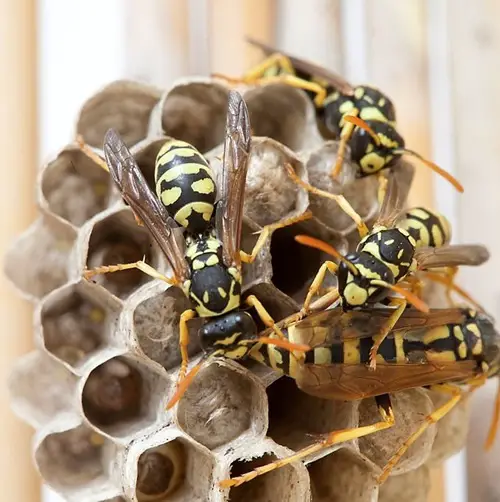Are you looking for ways to Get Rid of Yellow Jackets? These tips will definitely help to keep them at bay.

Having yellow jackets in your home and garden can be dangerous, especially if you have little kids around. Here’s how to get rid of them for good.
Yellow Jackets Facts
Yellow jackets are quite common in North America. They have black and yellow vertical stripes on the body and can be 10 to 16 mm long. These wasps make their nests in hollow trees, crevices, and other congested areas.
Yellow jackets feed on other insects, human food, and sweets. You can easily see them near garbage cans or open food sources, especially during summertime. They can be aggressive and sting multiple times, causing severe pain and allergies.
Important: Yellow jacket stings can be quite painful. However, some people may have allergic reactions to it, and it may cause severe symptoms like difficulty in breathing, hives, swelling of the face and throat, and in extreme cases, anaphylaxis – which can be life-threatening.
What Attracts Yellow Jackets?

Sweet items like soda, fruit juices, and ripe fruits act like magnets to yellow jackets. Apart from these, meat, fish, and pet food (Protein-rich items) also attract them a lot.
As these are mainly scavengers, they are constantly on the lookout for food near trash and compost piles.
To ensure they don’t trouble you, keep the above-mentioned items covered. Also, properly seal your garbage cans and keep compost bins covered always.
How to Get Rid of Yellow Jackets?

1. Peppermint Oil Solution
Mix a few drops of peppermint/mint oil with a few drops of dish soap and water. Stir well, and spray this solution where you find the wasps. As they find its smell irritating – they’ll be away.
2. Make Traps
A simple homemade trap can be made using a plastic bottle – cut it in half and invert the top part into the bottom one creating a funnel. Now, fill it with a bit of water, sugar, and a few drops of dish soap. Yellow jackets will be attracted to it and will drown.
3. Use Cucumber Slices
The acidic note and smell of these slices is something yellow jackets are really not fond of. Put the slices where they frequent to keep them away.
4. Vinegar to the Rescue!
You can also use a solution of vinegar, sugar, and a few drops of dish soap. Pour it into a shallow bowl – the vinegar’s strong scent will attract these insects, and they’ll drown in the liquid.
5. Make a Garlic Spray
Crush a few garlic cloves and mix them in water. Keep it for 5-7 days to let it work its magic! Now, pour the solution into a spray bottle, shake well, and use it around areas where these wasps are frequent. They hate its smell, and it will go away.
6. Fake Nests
Yellow jackets do not like to be near any other wasp nest/s. So, you can trick them by hanging a fake nest, which is surely going to spook them out.
7. Blocking Nest Access
If you find a yellow jacket nest, simply cover its opening with a bowl or box. This will trap the wasps inside, and they won’t be able to get out. The ones that can’t go inside will go away.
8. Aerosol Spray Treatment
You can use special sprays made for wasps. They have a long nozzle to reach the nest from a safe distance. Spray enough to soak the nest completely.
9. Electric Zappers
Electric zappers can help you eliminate yellow jackets – all you have to do is zap them! Simple!
10. Professional Help
If these home remedies don’t work, it’ll be a good idea to get professional help. They know how to deal with serious infestations and can give you peace of mind. Also, it is a safe way to do it, as the stings from these wasps can be very painful.


